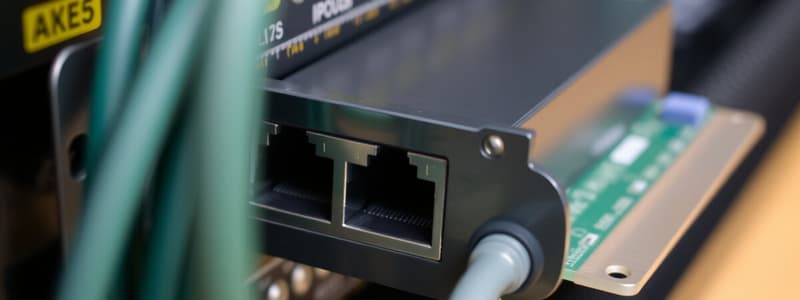Podcast
Questions and Answers
What is the primary purpose of the encryption/decryption technique used by Maria and Ann?
What is the primary purpose of the encryption/decryption technique used by Maria and Ann?
- To make their letters attractive
- To ensure quicker mail delivery
- To create more letters
- To prevent unauthorized access to their messages (correct)
How many machines do Maria and Ann each have for their communication process?
How many machines do Maria and Ann each have for their communication process?
- Two machines each
- Four machines each
- One machine each
- Three machines each (correct)
At which layer does the machine create the plaintext before encryption?
At which layer does the machine create the plaintext before encryption?
- Second layer
- All layers
- First layer
- Third layer (correct)
What does the first layer machine do after taking the cipher text from Maria's letter?
What does the first layer machine do after taking the cipher text from Maria's letter?
What is the main advantage of protocol layering in their communication process?
What is the main advantage of protocol layering in their communication process?
What is the primary function of a Network Interface Card (NIC)?
What is the primary function of a Network Interface Card (NIC)?
Which of the following statements about modems is true?
Which of the following statements about modems is true?
How does a wired NIC typically connect to a network?
How does a wired NIC typically connect to a network?
Which term is synonymous with Network Interface Card (NIC)?
Which term is synonymous with Network Interface Card (NIC)?
Which type of NIC allows devices to connect to a network without physical cables?
Which type of NIC allows devices to connect to a network without physical cables?
Flashcards are hidden until you start studying
Study Notes
Types of Network Devices
- Network Interface Card (NIC): Essential for any computer/device to connect to a network. Also known as Ethernet card, LAN card, network adapter, or Terminal Access Point (TAP).
- Modem: Connects computers to the internet, converting data signals between digital and analog formats.
- Hub: A basic networking device that connects multiple devices in a network, forwarding data to all ports.
- Switch: Operates similarly to a hub but routes data to specific devices, improving efficiency and network performance.
- Router: Directs data packets between networks and manages traffic, ensuring data packets reach their destination.
- Bridge: Connects and filters traffic between two or more network segments, enhancing network efficiency.
- Gateway: Acts as a point of entry for data to pass between different networks, often translating protocols.
Network Interface Card (NIC)
- Crucial for physical connectivity between devices and networks, functioning at the physical and data link layers.
- Wired NICs use Ethernet cables, while wireless NICs connect via radio waves.
- Present in all devices requiring network connectivity, including switches and routers.
Modem Functionality
- Converts data signals for internet connectivity.
- Facilitates secure communication, often employing encryption techniques to protect data during transmission.
TCP/IP Protocol Suite
- Transmission Control Protocol/Internet Protocol (TCP/IP): A widely used protocol suite structured in layers for effective data transmission over the internet.
- Dynamic Host Configuration Protocol (DHCP): Allocates IP addresses to devices connecting to the network.
- Address Resolution Protocol (ARP): Resolves network-layer addresses to link-layer (hardware) addresses.
- Reverse Address Resolution Protocol (RARP): Identifies network-layer addresses from link-layer addresses.
Data Link Layer
- Responsible for transferring packets through various network links (LANs and WANs) determined by routers.
- Handles packet encapsulation in frames, with protocols providing varying services for error detection and correction.
- Supports standard and proprietary protocols, allowing flexibility in link communication.
- Ensures reliable data transfer by managing connections through both wired and wireless links.
Summary of Layers in TCP/IP
- Physical Layer: Handles the raw bits of data.
- Data Link Layer: Frames data into packets and conducts error checking.
- Network Layer: Routes packets to their destination.
- Transport Layer: Manages data delivery between specific processes, ensuring proper order and flow control.
- Session Layer: Establishes and maintains communication sessions.
- Presentation Layer: Converts data into a format readable by application layers.
- Application Layer: Interfaces with end-user applications, presenting the final output.
Studying That Suits You
Use AI to generate personalized quizzes and flashcards to suit your learning preferences.




